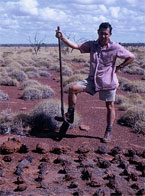Revered Geochemist
Port Chalmers-born Smithsonian scientist Brian Harold Mason, who was internationally known for his study of meteorites and moon rocks and who was the first to discover that a rock found in Antarctica came from the moon, has died at his home in the United States, aged 92. “Brian Mason was probably the best known and most revered geochemist of his generation,” said chair of the Department of Mineral Sciences at the Smithsonian’s National Museum of Natural History Sorena Sorensen. “He was one of the last polymaths of the earth sciences that we’ll ever see. He could look at a rock and know something important about it. He could pick it up and elicit its story.” While examining meteorites collected by US expeditions to Antarctica, Mason wrote in his notes that they seemed to be rocks from the moon, an idea that astrophysicists had said was impossible. Unwilling to show up other scholars in the field, his published comment was that they “had a passing resemblance to certain Apollo 15 lunar rocks.” Within a year, other scientists agreed. It wasn’t the first or last time his work forced a reconsideration of an entire field. In recognition of his accomplishments, an asteroid appearing between Mars and Jupiter was named 12926Brianmason. Two minerals, Brianite and Stenhuggarite (from the Swedish “stenhuggar,” meaning “mason”) also carry his name. Mason graduated from New Zealand’s University of Canterbury in 1936, from which he later received master’s degrees in chemistry and geology. He became a US citizen in the 1970s. Among his many honors, he won the Leonard Medal from the Meteoritical Society in 1972 and the Roebling Medal from the Mineralogical Society of America in 1993.
Brian Harold Mason: April 18 1917 – December 3 2009














